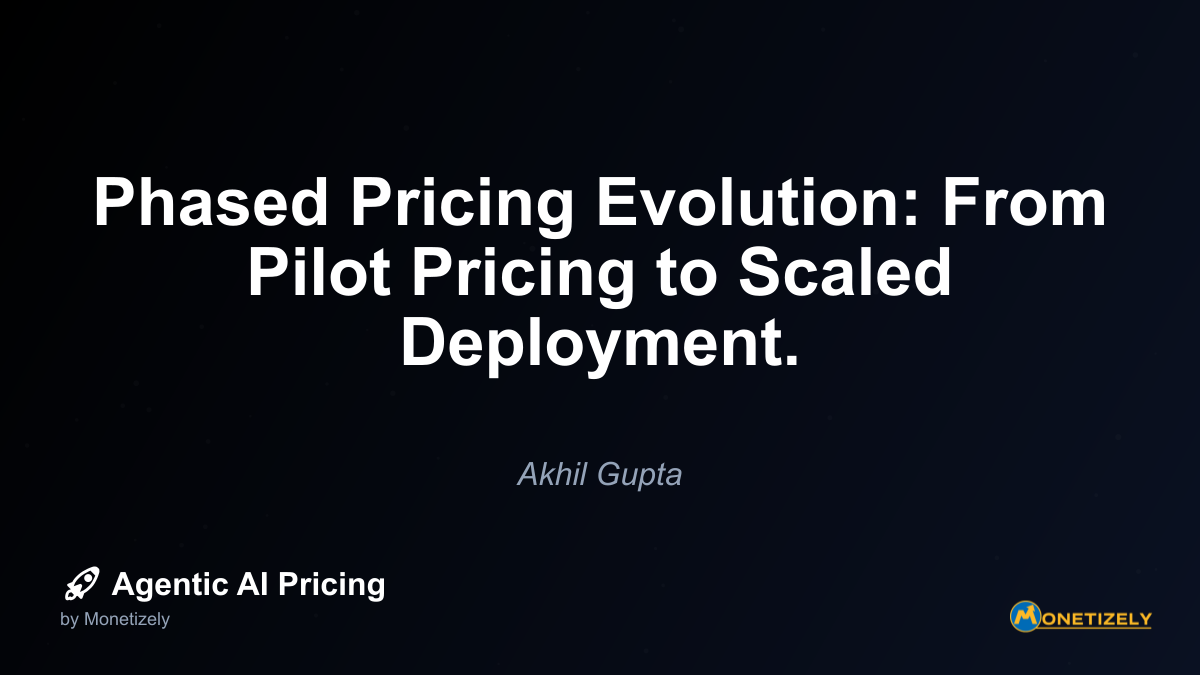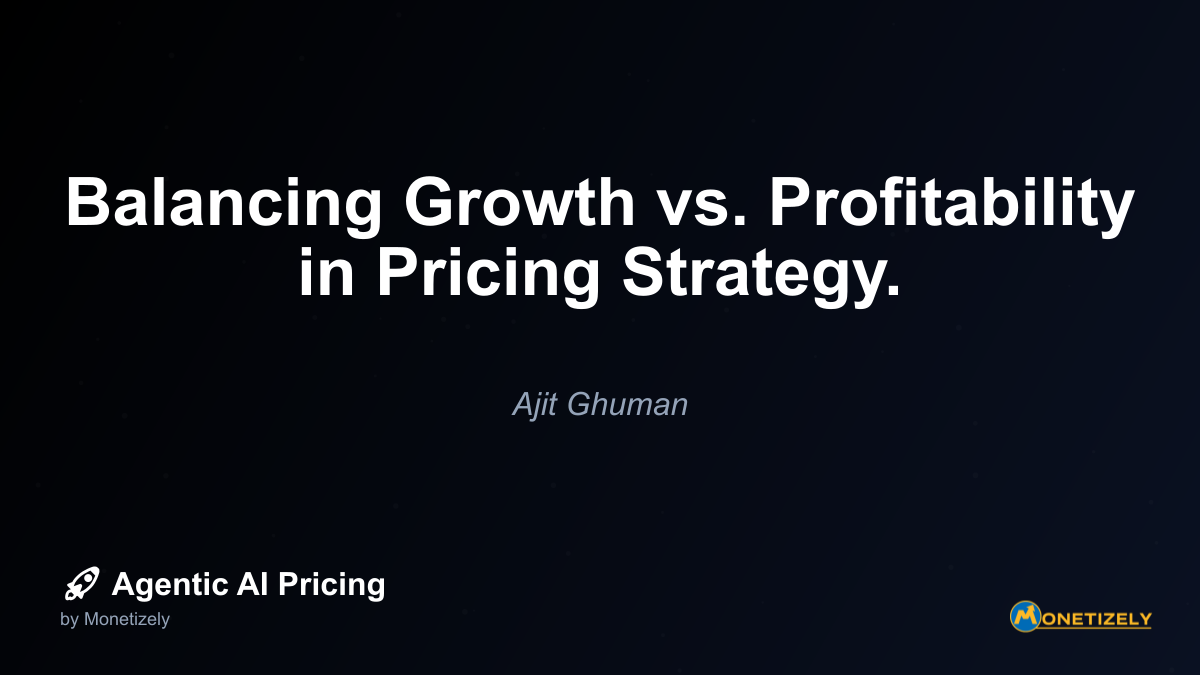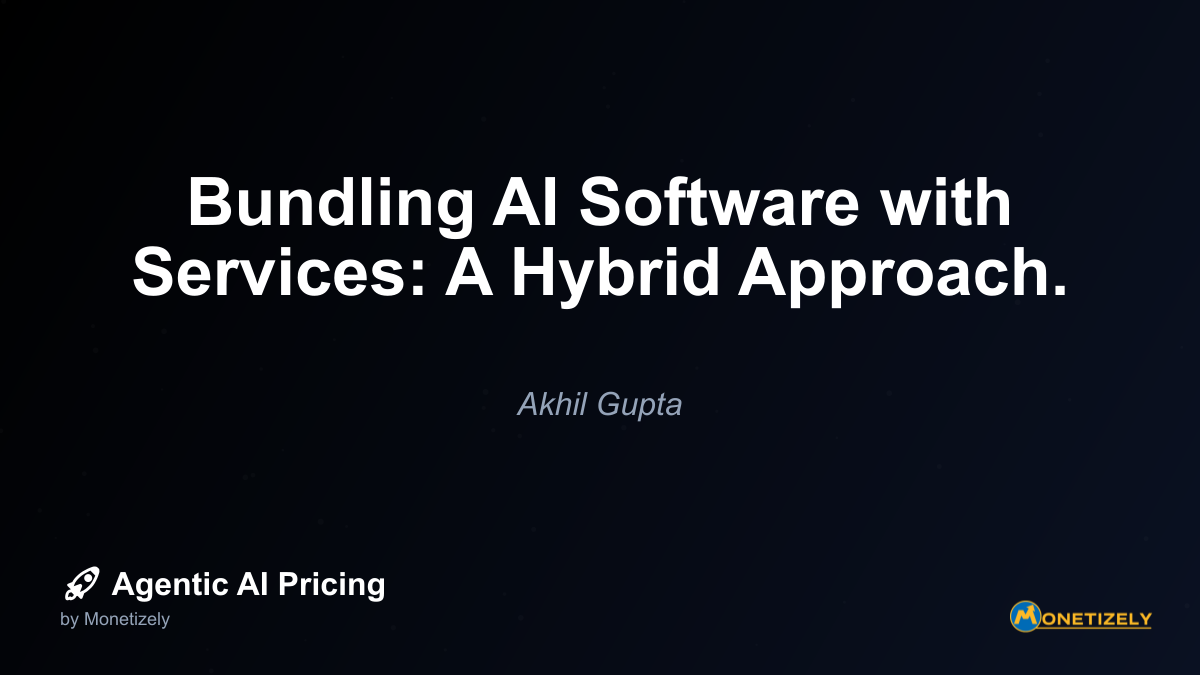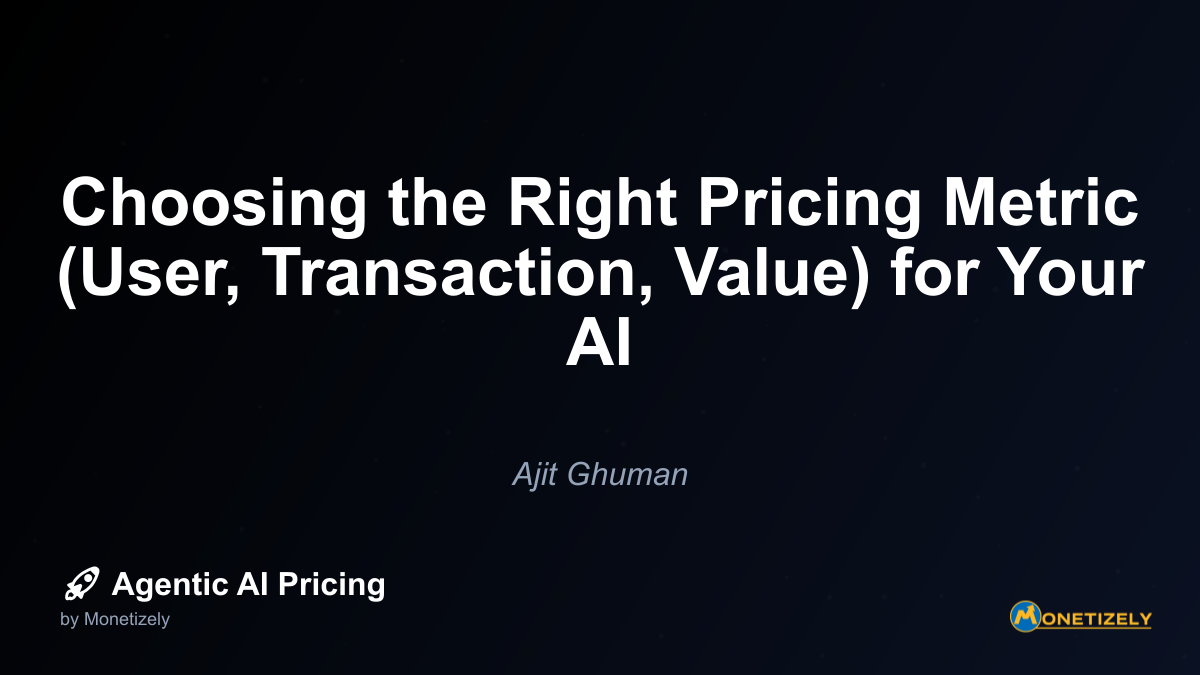· Akhil Gupta · Strategy & Planning · 8 min read
Phased Pricing Evolution: From Pilot Pricing to Scaled Deployment.
AI and SaaS Pricing Masterclass
Learn the art of strategic pricing directly from industry experts. Our comprehensive course provides frameworks and methodologies for optimizing your pricing strategy in the evolving AI landscape. Earn a professional certification that can be imported directly to your LinkedIn profile.

Case Study: Pilot Pricing Success
Consider the experience of SupplyChainAI, an agentic solution for inventory optimization. During their pilot phase, they implemented a “Success-Triggered Pricing” model with early adopters:
- Initial 90-day implementation at no cost
- Customers only began paying after the AI demonstrated a 5% reduction in inventory carrying costs
- Payment structure: 30% of documented savings for 12 months following the successful pilot
- Guaranteed minimum savings of 2x the cost of the solution
This approach resulted in a 78% conversion rate from pilot to paid implementation, significantly higher than the industry average of 42% for AI solutions. By aligning the pricing trigger with demonstrated value, SupplyChainAI removed adoption barriers while establishing clear value metrics.
Phase 2: Early Adoption Pricing – Building Value Perception
As an agentic AI solution moves beyond the pilot phase into early adoption, pricing strategy must evolve to reflect growing confidence in value delivery while still acknowledging the emerging nature of the solution.
Characteristics of Effective Early Adoption Pricing
1. Hybrid Value Capture
Early adoption pricing typically combines fixed and variable elements to balance predictability with value-based pricing. This hybrid approach provides revenue stability for the provider while beginning to align pricing with value creation.
2. Increased Pricing Sophistication
While maintaining relative simplicity, early adoption pricing introduces more nuanced mechanisms to capture different usage patterns and value scenarios. This might include:
- Basic tiering based on functional access
- Volume-based discounting structures
- Simple usage parameters (users, transactions, etc.)
- Optional add-ons for enhanced capabilities
3. Reference Customer Development
Early adoption pricing should strategically cultivate reference customers who can validate the solution’s value. This might involve preferential pricing for customers willing to serve as references, participate in case studies, or provide testimonials.
Common Early Adoption Pricing Models
Several approaches work effectively during the early adoption phase:
Tiered Usage Pricing: Simple usage tiers with clear boundaries and predictable costs (e.g., “Up to 1,000 AI-processed documents for $X, up to 5,000 for $Y”).
Hybrid Subscription + Usage: A base subscription fee providing access to core functionality, combined with usage-based charges for variable consumption elements.
Function-Based Pricing: Different pricing for different AI capabilities, allowing customers to pay only for the specific functionality they need.
Shared Success Models: Revenue sharing or gain-sharing arrangements where the provider receives a percentage of documented value created.
Building the Value Narrative
The early adoption phase is critical for establishing the value narrative that will support higher pricing in later phases. This involves:
1. Value Documentation Framework
Implementing systematic processes for documenting value creation across different customer scenarios and use cases.
2. ROI Calculator Development
Creating and refining ROI calculation tools that prospective customers can use to model expected value.
3. Competitive Differentiation
Establishing clear differentiation from both traditional non-AI solutions and competing AI offerings.
Further reading on the evolution of agentic AI pricing models compared to traditional software provides valuable context for understanding this differentiation process.
Case Study: Early Adoption Pricing Evolution
LegalDocAI, an agentic solution for contract review and risk analysis, successfully transitioned from pilot to early adoption with this pricing evolution:
Pilot Phase:
- Flat fee of $500/month for unlimited access
- 60-day money-back guarantee
- No minimum commitment period
Early Adoption Phase:
- Base platform fee: $1,000/month
- Per-contract review: $15 for standard contracts, $45 for complex contracts
- Volume discounts starting at 100 contracts/month
- Quarterly value assessment included
This transition increased average customer value by 320% while maintaining a 91% retention rate from pilot customers. The key success factor was introducing usage-based elements that aligned with customer value perception (time saved per contract review) while maintaining predictability through the base platform fee.
Phase 3: Scaled Deployment – Value-Aligned Pricing
As an agentic AI solution achieves market validation and demonstrates consistent value delivery, pricing strategy can evolve to more sophisticated models that maximize revenue while maintaining competitive positioning.
Characteristics of Effective Scaled Deployment Pricing
1. Value-Based Orientation
Mature pricing for agentic AI solutions should primarily align with value creation rather than costs or competitive benchmarks. This requires robust understanding of how different customers derive and perceive value.
2. Segmented Approach
Scaled deployment typically involves serving multiple market segments with different needs, value perceptions, and willingness to pay. Pricing strategy should reflect these differences through appropriate segmentation.
3. Ecosystem Integration
As the solution becomes part of broader customer workflows and technology ecosystems, pricing should account for integration value and ecosystem effects.
4. Predictable Growth Paths
Customers should see clear, predictable pricing as their usage and value derived from the solution grows, avoiding unexpected cost spikes that might trigger reassessment.
Common Scaled Deployment Pricing Models
Several sophisticated pricing approaches become viable at this stage:
Outcome-Based Pricing: Directly tying pricing to measurable business outcomes achieved through the AI solution (e.g., percentage of cost savings, revenue generated, or productivity improvements).
Value-Metric Pricing: Identifying and pricing based on specific metrics that correlate with customer value (e.g., decisions automated, processing time saved, accuracy improvements).
Consumption-Based Pricing: Sophisticated usage-based models that account for different types of resources consumed (compute, storage, API calls) with appropriate weighting.
Portfolio Pricing: Bundling different AI capabilities with cross-solution discounting to encourage broader adoption across the customer organization.
Explore how performance-based pricing models are reshaping the agentic AI landscape for mature solutions.
Building Long-Term Value Capture
Scaled deployment pricing should incorporate mechanisms for capturing increasing value over time:
1. Value-Based Escalation
Contract structures that increase pricing as specific value thresholds are achieved, rather than based solely on time periods.
2. Expansion Incentives
Pricing structures that encourage expansion to additional use cases, departments, or functionality through decreasing marginal costs.
3. Partnership Economics
For the most mature solutions, evolving toward partnership models where both provider and customer have aligned incentives for maximizing value creation.
4. Data Value Monetization
Capturing the increasing value of data and model improvements through appropriate pricing mechanisms that reward long-term customers while monetizing the accumulated intellectual property.
Case Study: Scaled Deployment Pricing Sophistication
FinancialForecastAI, an agentic solution for financial planning and analysis, implemented this sophisticated pricing approach at scale:
Core Platform Tier:
- Base subscription: $5,000/month
- Includes standard forecasting capabilities and integration with major ERP systems
- Unlimited users within finance department
Value-Based Components:
- 0.5% of documented cost savings from improved inventory management
- 0.75% of revenue protected through improved cash flow forecasting
- 1% of new revenue opportunities identified by the AI
Consumption Elements:
- Scenario modeling: $250 per complex scenario beyond monthly allocation
- Custom model training: $10,000 per specialized model
- API access for custom applications: $0.05 per call
This multi-dimensional approach resulted in average annual contract values exceeding $250,000 while maintaining a 94% renewal rate. Most importantly, it aligned the vendor’s success with measurable customer outcomes, creating a virtuous cycle of value creation and capture.
Navigating the Transition Between Pricing Phases
The transitions between pricing phases represent critical junctures that require careful planning and execution. Mishandled transitions can lead to customer dissatisfaction, revenue leakage, or competitive vulnerability.
Key Considerations for Effective Phase Transitions
1. Grandfathering Strategies
Determining whether and how to maintain preferential pricing for early customers as the solution matures and pricing evolves.
2. Communication Timeline
Establishing clear communication protocols for pricing changes, typically involving:
- Advance notice (3-6 months for significant changes)
- Clear explanation of value alignment
- Transition support resources
- Optional phased implementation
3. Value Demonstration
Ensuring robust value documentation before transitioning to more sophisticated pricing models that assume value understanding.
4. Contract Structures
Designing initial contracts with appropriate terms, renewal provisions, and price change mechanisms to facilitate future transitions.
Best Practices for Pricing Evolution
Several practices have proven effective in managing the evolution of pricing across phases:
Progressive Disclosure: Introducing pricing complexity gradually as customers become more sophisticated in understanding and measuring value.
Value Benchmarking: Establishing clear value benchmarks before transitioning to more value-aligned pricing models.
Pilot Clauses in Contracts: Including provisions in pilot agreements that outline potential pricing evolution paths based on success criteria.
Customer Success Alignment: Ensuring customer success resources are aligned with pricing transitions to maintain satisfaction through changes.
Measuring Success Across the Pricing Evolution
Effective measurement frameworks must evolve alongside pricing strategies to properly evaluate success at each phase.
Phase 1: Pilot Pricing Metrics
During the pilot phase, key metrics should focus on adoption and learning:
- Pilot conversion rate (pilots started vs. completed)
- Conversion to paid customer rate
- Customer-reported value perception
- Feedback quality and quantity
- Time to first value
- Technical success metrics (integration success, uptime, etc.)
Phase 2: Early Adoption Metrics
As the solution moves to early adoption, metrics should begin incorporating financial and growth elements:
- Customer acquisition cost (CAC)
- Average contract value (ACV)
- Net revenue retention
- Expansion within pilot accounts
- Reference customer development
- Competitive win/loss rate
- Price realization (actual vs. list price)
Phase 3: Scaled Deployment Metrics
Mature solutions should be measured against sophisticated financial and strategic metrics:
- Customer lifetime value (LTV)
- LTV:CAC ratio
- Revenue per customer segment
- Value-based pricing realization
- Margin by customer and segment
- Pricing power (ability to increase prices)
- Market share and penetration
- Ecosystem influence and network effects
Conclusion: Creating Your Phased Pricing Roadmap
The evolution of pricing for agentic AI solutions should be planned strategically from the outset, even as it adapts to market realities and learning. A comprehensive pricing roadmap should include:
- Clear phase definitions with trigger criteria for transitions
- Value measurement frameworks appropriate to each phase
- Customer communication strategies for pricing evolution
- Contract structures that facilitate transitions
- Competitive positioning considerations across the evolution
By approaching agentic AI pricing as an evolutionary journey rather than a static decision, providers can maximize both adoption and revenue capture as their solutions mature. This phased approach acknowledges the reality that both the solution and customer understanding evolve over time, requiring pricing models that can evolve in parallel.
The most successful agentic AI providers view pricing strategy not as a one-time decision but as a continuous process of alignment between value creation and value capture. By implementing a thoughtful phased approach, they create sustainable business models that reward innovation while encouraging adoption—ultimately accelerating the positive impact of agentic AI across industries.
Co-Founder & COO
Akhil is an Engineering leader with over 16+ years of experience in building, managing and scaling web-scale, high throughput enterprise applications and teams. He has worked with and led technology teams at FabAlley, BuildSupply and Healthians. He is a graduate from Delhi College of Engineering and UC Berkeley certified CTO.
Pricing Strategy Audit
Let our experts analyze your current pricing strategy and identify opportunities for improvement. Our data-driven assessment will help you unlock untapped revenue potential and optimize your AI pricing approach.




